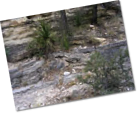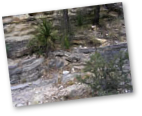



Becky Yarbrough
El Capitan Mountain
N 310 51.258’ W 1040 50.645’
Elevation: 4937’ (at the point where we took the photo)
Content:
The El Capitan is a part of the Guadalupe Mountains National Park, which is the largest fossil reef in the world. The El Capitan Mountain was formed by an ancient reef system during the Permian Era about 250 million years ago. The whole area was once covered by an ancient ocean. The reef was formed by sponges and algae and not by corals as the modern day reefs are, so the fossils look very similar to a spongy rock. As the reef was exposed to air from the uplift of the plates, pieces of the reef died then broke off and fell or rolled to the bottom of the sea where they were later covered by silt, soil and sand and the reef pieces became a part of the sedimentary rock found in this area.
We visited the park at the McKittrick Canyon Visitors Center. While we were there we hiked up to an elevation of 5173’ along the fore-reef to El Capitan to view the rock formations of the reef. As we traveled we saw examples of how the reef broke apart and traveled or rolled along the fore-reef and became a part of the sedimentary rock layers that are now visible to all because of the erosion of the area.
Reflection:
As I was standing at the edge of the fore-reef and looking up toward the top of the El Capitan Mountain I tried to imagine what it must have looked like 250 million years ago with the sea all around us and the reef starting to break through the waves. I was standing on the bottom of the Permian Sea and looking up towards the surface of the ocean. It was an amazing thought and vision. Keith Brownlee gave us detailed descriptions of the area and how the fossil reef was probably formed. One of the unique things he pointed out to us was the formation of the sedimentary rocks around the pieces of the reef that had broken off and tumbled down to the bottom of the sea only to become a part of the sedimentary rock formation along the edge of the ancient sea bed.
Keith Brownlee pointing out a few rock formations along the edge of the El Capitan Mountain.
 Reef pieces that have been covered by sand and silt to form a sandwiched layer of sedimentary rock, the lump is a piece of the ancient reef.
Reef pieces that have been covered by sand and silt to form a sandwiched layer of sedimentary rock, the lump is a piece of the ancient reef.Media Resource:


Wednesday, June 7, 2006

















